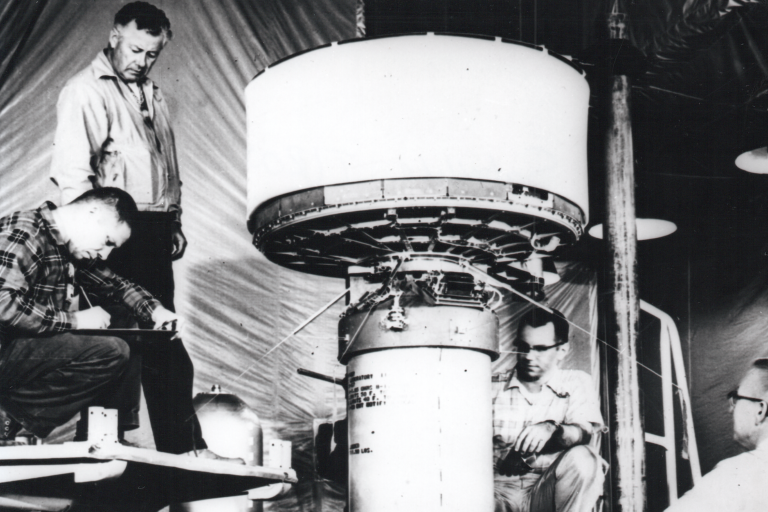20th century

After the end of World War II, the rebuilding of economies and the boom in maritime and air transport, ushered in an expansion of observational and telecommunications capabilities on land, at sea and in the air. But there were still large gaps.
The InternationaI Geophysical Year 1957-58 tried to fill these gaps with a coordinated push for observations covering the entire surface of the Earth. The meteorological programme included measurements of solar radiation and atmospheric ozone – and so helped increase understanding of the Earth’s protective ozone layer and the need to safeguard it from destructive chemicals.
Coinciding with this, the advent of meteorological satellites marked the beginning of a new era of observational data coverage for the whole globe. In 1957, the Soviet Union launched the first Earth-orbiting satellites SPUTNIK-1 and SPUTNIK-2. The EXPLORER-1 satellite was launched by the United States on 2 January 1958, and the world’s first dedicated weather satellite, the Television Infrared Observation Satellite (TIROS-1), on 1 April 1960.
As a result, the UN General Assembly requested WMO to investigate the potential of weather satellites as part of the agenda for the peaceful use of outer space. Setting aside their political differences, the United States and the USSR produced a report that led WMO to launch the World Weather Watch Programme in 1963. It became a cornerstone for atmospheric sciences, meteorological services and global cooperation.
The World Weather Watch celebrates its 60th birthday in 2023. It pre-dates the other WWW - World Wide Web - and is just as important. It produces meteorological observations over land, on sea and from space; prepares weather forecasts and warnings; exchanges information globally and in real time in a free and unrestricted manner.
The World Weather Watch laid the foundations for more modern scientific insights and technological advances in computing, telecommunications and satellites and served as a role model for international collaborative programmes such as the Global Climate Observing System (GCOS) and Global Ocean Observing System (GOOS).
The development of Numerical Weather Prediction (NWP) programmes in the late 20th century was as significant as the progress in satellite technology. NWP opened up new dimensions, allowing meteorologists to apply with greater accuracy their weather-related data to serve society.
Challenges
Throughout history, storms, floods, droughts and other extreme weather have caused massive loss of life and livelihoods. The 1970s opened with a series of severe weather events that thrust meteorology into the public mainstream and which were watched on television in homes around the world.
The WMO Tropical Cyclone Programme was born from tragedy. The world’s deadliest known tropical cyclone killed up to 500 000 people in November 1970 in what is now Bangladesh. The Programme covers all ocean basins prone to tropical cyclones and facilitates observations, research, coordination and communication to improve monitoring, forecasting and warning. The unique global coordination and cooperation under the umbrella of WMO has led to dramatic advances in the accuracy of tropical cyclone forecasts and warnings. This has saved many thousands of lives over the years.
The Water Decade – otherwise known as the International Drinking Water Supply and Sanitation Decade, took place in the 1980s. The aim was to alert the international community to the growing pressure on freshwater resources throughout the world. About 70 per cent of the world is covered with water, but only a tiny fraction is readily accessible for direct human use. The global community therefore recognized the importance of oceanographic and hydrological services for climate prediction, water resource management and security. In the intervening decades, the need for these services has increased as the challenge of water-related hazards and security have grown.
Climate change also moved closer to centre stage in the 1970s and 1980s as a result of concern that increasing greenhouse gases emitted into the atmosphere from human activities would lead to major changes in the climate.
In 1976 WMO issued its first statement on climate change and set up the World Climate Programme in 1979. The World Climate Research Programme (co-sponsored by WMO) was established in 1980 and climate science made a further leap in 1988 with the establishment of the Intergovernmental Panel on Climate Change (IPCC).
The following year WMO and UNEP initiated the negotiation process for a UN Framework Convention on Climate Change (UNFCCC). The more climate became an international policy issue, the more WMO was called upon to provide scientific data and prediction through initiatives such as its Global Atmosphere Watch programme and World Weather Research Programme.
As the 20th century progressed, the early warnings from climate scientists because louder – and the impacts of climate change became more apparent. Unfortunately this did not result in corresponding climate action. The longer we delay in curbing greenhouse gas emissions, the more difficult and expensive it will become to adapt.
